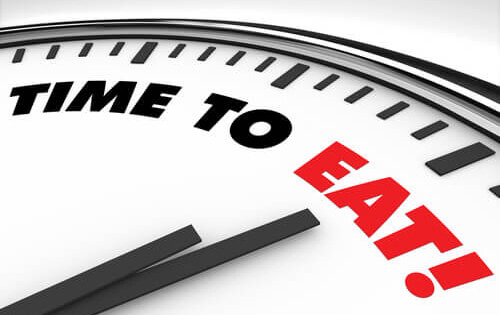Meal Frequency – What’s Enough

(Posted on Apr 02, 2012)
Meal Frequency is based on metabolism. Metabolism is a complex idea to understand with all the science behind it. From the aspects of cellular respiration, ATP production, electron transport chain, glycolysis, Kreb’s cycle, etc. You have to think of it as your metabolism being a camp fire, and the food you ingest being the wood needed for the fire to burn. As you feed your body you are adding wood to your fire. When you add wood to a fire, the fire grows and burns hotter, and if you keep adding wood to this fire periodically, it will take longer to burn out. This illustrates that the more frequent you eat, the more active your metabolism becomes. Now before you start eating everything in your house and have 10 huge meals per day, you need to also think about calories and relate your caloric intake amount to the amount of wood that can be used. For instance, you have a specific amount of calories needed per day for maintenance, fat loss, and/or weight gain. So that specific number is the amount of wood that can be used for each day. If you use up all of your wood too quickly you will eventually need more wood to keep the fire burning which will mean more calories added to your day. If you don’t use all of your wood, your fire will not burn at its full potential or may even eventually burn out.
Now you need to take into consideration that each day will be broken down into around 6 to 8 meals (this depends on what time you choose to throw yourself out of bed in the morning). From these 6 to 8 meals, or times to put wood into your fire, you need to spread out the amount of wood used each time so you will be able to feed your fire 6 to 8 times without running out of/or not using all of your wood. For example, if your caloric intake is 3000 calories per day then that is the number you need to strive for. What you do next is divide that 3000 into 6 meals and you get 500 calories to spend per meal. Every meal will not consist of the same amount of calories (as I will explain), so planning ahead of time is crucial in developing a system that works best for you.
The daily caloric intake will vary from person to person depending on Basal Rate Metabolism, your Somatotype, your age, height, weight, and all of those fun calculations to give that precise number we all long for. The thing is, you can find all of those calculations via the internet and be able to figure out around what your body needs. For now, you need to lay down a foundation. Figure out the time you work, the times you can eat, the time you will train and divide the day into 3 hours sections. This meaning that if you wake up at 5:30am and have breakfast at 6am (meal 1), then three hours later (at 9am) will be meal 2. From there every three hours (12pm/3pm/6pm/9pm) will be the times for your other meals. Obviously the world doesn’t work that easily, so it’s up to you to make sure you get as close to that 3 hour mark as possible. Even if you have to put some meals 2 hours apart and other 4 hours apart, try to get it as close as possible that’s yet still convenient for you.
There are certain times of the day that call for more calories than others. For instance, your meal 1 should be full in complex carbohydrates, proteins, and fats with a substantial amount of calories to start your day off. Coming off a fast calls for a good supply of calories and nutrients to help provide energy for the day ahead. Compared to meal 1, your meal 6 will be significantly reduced in the number of calories as well as the carbohydrates. Your pre-workout meal should be consumed about an hour before you workout, and should be rich in protein and fat. Most days I choose not to add carbohydrates, but when I’m feeling sluggish I do not hesitate to throw some into the mix. I usually use rice cakes covered in a tablespoon or two of Almond Butter. I am not against carbohydrates pre-workout, I just feel as if I ingest enough in my previous meals. Your PWO shake, as stated before, should be high in protein and carbohydrates. There are other supplements to add to the shake but that will be discussed in the supplement section. Now depending on what time of day you train, your post work out meal (the meal following your shake) should be consistent with your protein, carbohydrates, and fats. This meal should be consumed an hour after your shake, unless you train late at night, then you won’t need this meal to be as heavy on the carbohydrate and fat intake. What I am trying to get across to you is that you should have an understanding of which meals need which macronutrients. By this I mean, when to load up on carbs (early meals and PWO) and when to stay away from them (later meals), when to take in fats (early meals and pre-workout), and when to load up on protein (PWO and meal 1) and when to keep the protein consistent (every other meal). When that’s all figured out, only then you can break down which meals need what and at what time do they need to be consumed. The main concept here is that you need to be sure to spread out your meals evenly, and meet the requirements of your caloric intake and the percentages of your macronutrients.
About the Author Vinny Russo
I have a Bachelors in Science, I am PN.1 certified, NFPT certified, and in the process of obtaining my CN.L (Clinical Nutritional License) and my MSCN (Masters in Applied Clinical Nutrition). My mission is help you reach your health-related goals while educating throughout our journey together. The goal is to have you become a master of your own health by teaching you how nutrition works and what works best for your individual body.
Related Posts
Podcast with Chris Tutela – #13: Get Ripped, Strong and Healthy with Vinny Russo
The 6 Principles Of Getting Lean
8 Secrets Of Successful Contest Prep!
6 Sweet Nighttime Protein Treats
3 Delicious Protein-Rich Treats!
6 Protein-Rich Morning Meals
